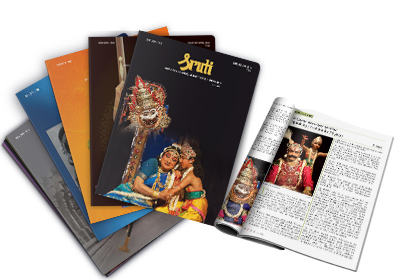
Sruti asked RANJABATI SIRCAR to tell us about her formative years, her work and the ideas and experiences which have influenced her in her evolution as a creative dancer. Her response:
Early Years
I have been learning dance with my mother. I was a recalcitrant student until I got involved at the age of 12 in a production with her American students, all much older than me. I grew up with her words on the affirmation of the spine, as a woman, ringing in my ears. I went to an experimental school in the U.S. which emphasised creativity and analytical understanding. I felt this as a strength throughout college and my dancer career. At 13, I worked with my classmates in this school on a creative theatre project which we wrote, enacted, and produced- a modern re-telling of fairy tales. I experienced the joy of working in a team. I spent a year in India when I was 14-15, learning Kathakali from Guru Govindan Kutty and Rabindra Sangeet from Debabrata Biswas. After returning to the U.S., I knew I had to go back to India.
Influences
I was a feminist and a Marxist throughout my college years. This had a deep influence on my early work with Dancers' Guild from 1983. At the end of 1983, I became involved in the Pan Cultural Performance Project which was John Martin's first multicultural, multidisciplinary theatre work. I had the opportunity to join his company but did not do so because I wanted to go deeper into the forms. But the experience and my first exposure to Kalaripayattu sparked my own thinking about the body and movement, and led me to develop ideas about centre, energy, line, and space that had been a part of my vocabulary since childhood through my mother. It also taught me a great deal about the importance and potential of improvisation techniques. I received training in classical and jazz piano as a child. Later, I learnt Hindustani classical music under Swapan Pakrashi and voice and theatre techniques from Gilles Petit of Paris. Later I started thinking about the relationship of sound to the body.
There were many other influences on my thinking. Like:
* My mother's interpretations of Tagore as a sensual, natural poet with a strong “ feminine" voice and powerful female characters.
* The use of the lower back in Kathakali as a pivot-point and the liberation of the face from prettiness.
* The use of the diaphragm in Bharatanatyam in creating linear energy and speed, and its outwardness and crispness. (Khagendranath Barman and Kalakshetra were the sources).
* The flow, inwardness and subtlety of Manipuri, to which I had been exposed from childhood. Also the upper torso as a fluid axis, like the symbol for eternity, the sideways. I could relate the confidence of this soft grace to the actual socioeconomic power of the Meitei woman which I experienced while accompanying my mother when she went to Manipur in connection with her doctoral degree field work there.
* The flexibility and strength manifest in yoga.
* The flow of Kalaripayattu and the freeing effect of the kick and the punch. (I had had karate lessons in the U.S. which I found too rough).
* The freedom of the pelvis and legs in Chhau, the harmonious flow from a central X axis.
* The face and body as subtle instruments for conveying satvika abhinaya which I learned from Kalanidhi Narayanan. Also the control and concentration required, the self-forgetting.
There were other experiences too which influenced me. For example:
* At the American Dance Festival in 1990, two things impressed me particularly. One concerned anatomy, the way of looking at the body from the inside. The other was the use of the body's own weight in relation to gravity (applying the principles underlying the Limon techniques). These made me think about the relationship of the moving body to natural forces.
* In Roshi John Game's ongoing Zen work, I noticed the concept of 'mindfulness' as the core of centring. It underscored the need to discover the 'natural' body once again and to understand how that relates to technique. Also it showed how the body, and particularly breathing techniques need to be modified to suit the environment.
Santiniketan, and Uday Shankar have never appealed to me personally as an artist. Tagore's poetry, prose, and ideas I still find inspiring— but then it is also same with the works of many others around the world. I admire Judith Jamison (principal dancerof the Alvin Ailey Company), and Shanta Rao, for their power; African and black dancers for their physicality and passion; and Chinese and Japanese traditional dancers and martial artists, for their presence.
On Chandralekha
Chandralekha's work is interesting and some of her ideas are worth hearing, but I do not feel that the way to modernise tradition is through reductionism and minimalism. Also, I find her approach dominated too much by the left-brain (analytical). She talks "organic" but her work is conceptual; she talks of "feminism" but I find her work very male in that it emphasises a direct " thrust". I also find the aspect of communication lacking when the work is seen on its own without verbiage.
Methodology
My mother would have an idea which I would immediately grasp and then seek to find a way of imparting to the group. Thus began the methodology. My own work is in finding, through preparation, the contemporary dance body, the body that is capable of diverse kinds of dynamics, energies, and movements; the body that can "carry" the density of emotion and pattern of contemporary choreography.
The first total application of the Navanritya method of training outside Dancers' Guild was in the choreography I did for the Yuva festival in London in 1992. It convinced me of the efficacy of the method. My conviction was reinforced by comments of the trainees in the U.K., the U.S. and Venezuela, such as: " T h e most complete form of body training..."; "Deep and sophisticated".
Classical to Contemporary
I did a few Bharatanatyam performances under my guru and had performed the other styles in the past. People were pushing me to become a classical dancer, they said I had all the assets. I hated this word, it made me feel like a commodity. I enjoyed classical dance and gave myself to it in order to absorb as much as I could. But I felt there was a communication distance between my sensibility as a contemporary individual and what the audience was seeing. A distance that was not there, for example, in Tomari Matir Kanya. My primary interest in classical training was always its creative application.
The themes of traditional dance are relevant when taken out of the context of religion/mythology and universalised-- the basic human themes, the navarasa, the setting of deep individual emotions against wide social events, the concept of ardhanareeswara as a holistic model of existence, etc. I don't think that a dancer has to make a social statement in her dance, but I feel there must be a clear sense of purpose which is psychophysically holistic and which reflects that sense of interconnectedness in every way, otherwise it becomes self-indulgence, whether intellectualised or melodramatic. Indian myths are rich and wonderful, but they may be too entangled in social and psychological structures for them to be directly communicative, unless re-interpreted, as in Tagore's Chitrangada, Iravati Karve's Draupadi, etc. I have tried to capture the "epic grandeur" of myth in Gangavataran. It is an exploration of the application of a modern approach to movement, freely using both literal and abstract images. It is also in some ways an exploration of my own relationship to the myth.
Technique
The unified whole" of which a movement is part, is nothing but a socio-historical "imprint". I love the human body. I couldn't bear to sit at a desk all the time, only using my head. My method is to impart a separate, stable " imprint" to the body, through a redefinition of the centre, and then allow that body to transform any movement naturally through that particular quality. When I do Nnatyarambha', it is no longer ' natyarambha' as I learned it; but it is what my contemporary dance body has acquired/interpreted it. It feels different, it is used differently. I didn't hit upon the exercises they have evolved, continue to evolve, through experience, trial and error, with many bodies and situations.
Often the need for healing of injuries led to exploration of why an injury happened and how that is related to a movement or even a style. Many things are dangerous to the body out of context of a complete training; each element has to be examined in terms of spinal alignment, musculature, skeletal articulation, etc. and related to concepts of centre and energy.
Dance & Music
For my solo work I select music from what I hear or allow it to evolve from sessions with musicians/composers. In group pieces, such as Thirsting River, I worked along with the composer and the musicians, using images and ideas. I look for certain qualities in music, to create atmosphere or emotions or characters.
Creative Works
Thirsting River was my first full group-piece. This is what won for me the Time Out/Dance Umbrella award in London in 1992. It was about process- from structure and symmetry to flow and continuity; from empty ritual to collective individualism, through strife, pain and shallow social custom. I hoped it would be a process of discovery for the dancers as well. I have co-directed several works with my mother: Tomari Matir Kanya, Chitrangada, War Drums (as assistant); Tasher Desh, Birds of Fire, Aranya Amrita, Charoiveti (as associate and co-choreographer).
I collaborated with voice-actor Gilles Petit in Paris in producing a solo item, in 1986. I choreographed some short pieces during 1986-90. In 1992, I composed Gangavataran. Fable for La Gran Sabana, begun in 1991, went through three different versions before arriving at the present piece in 1994. The last is a simple “magic realist" narrative dealing with basic human feelings and archetypes. A word on the narrative. I feel this is the oldest form of creative communication in the world. I relate the narrative to the deep psyche of humankind, and find strength in the model of the female storyteller- - from the shaman of tribal societies to my own grandmother.
Approach to Creative Work I tend to work in isolation, even for group items. But when working with a group I try to offer situations for improvisation, to combine “choreographing with" with "choreographing on". Most of what I do emerges basically from meditation. At present I am exploring the aspect of improvising during performance, within a certain frame/structure. I like the challenge of not knowing what's going to happen, the immediacy of “having to be there" totally.


